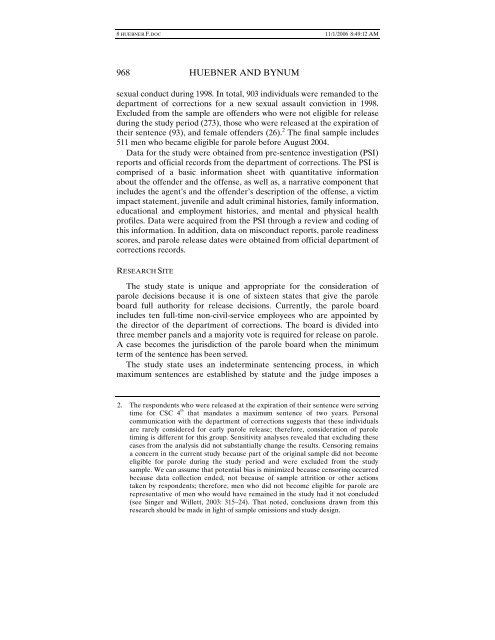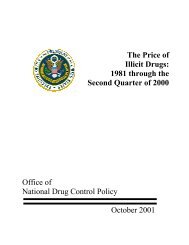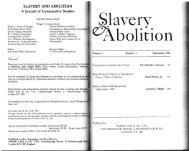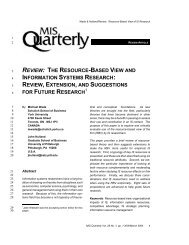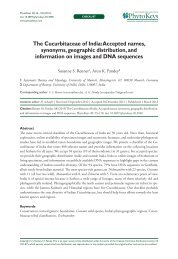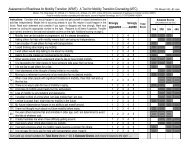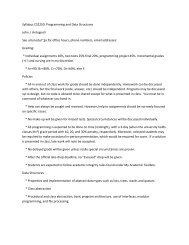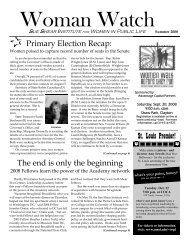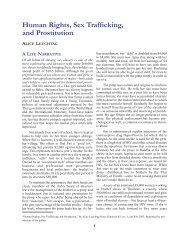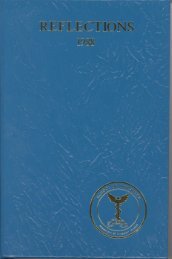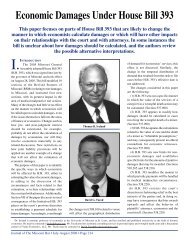an analysis of parole decision making using a sample of sex offenders
an analysis of parole decision making using a sample of sex offenders
an analysis of parole decision making using a sample of sex offenders
You also want an ePaper? Increase the reach of your titles
YUMPU automatically turns print PDFs into web optimized ePapers that Google loves.
8 HUEBNER F.DOC 11/1/2006 8:49:12 AM<br />
968 HUEBNER AND BYNUM<br />
<strong>sex</strong>ual conduct during 1998. In total, 903 individuals were rem<strong>an</strong>ded to the<br />
department <strong>of</strong> corrections for a new <strong>sex</strong>ual assault conviction in 1998.<br />
Excluded from the <strong>sample</strong> are <strong>of</strong>fenders who were not eligible for release<br />
during the study period (273), those who were released at the expiration <strong>of</strong><br />
their sentence (93), <strong>an</strong>d female <strong>of</strong>fenders (26). 2 The final <strong>sample</strong> includes<br />
511 men who became eligible for <strong>parole</strong> before August 2004.<br />
Data for the study were obtained from pre-sentence investigation (PSI)<br />
reports <strong>an</strong>d <strong>of</strong>ficial records from the department <strong>of</strong> corrections. The PSI is<br />
comprised <strong>of</strong> a basic information sheet with qu<strong>an</strong>titative information<br />
about the <strong>of</strong>fender <strong>an</strong>d the <strong>of</strong>fense, as well as, a narrative component that<br />
includes the agent’s <strong>an</strong>d the <strong>of</strong>fender’s description <strong>of</strong> the <strong>of</strong>fense, a victim<br />
impact statement, juvenile <strong>an</strong>d adult criminal histories, family information,<br />
educational <strong>an</strong>d employment histories, <strong>an</strong>d mental <strong>an</strong>d physical health<br />
pr<strong>of</strong>iles. Data were acquired from the PSI through a review <strong>an</strong>d coding <strong>of</strong><br />
this information. In addition, data on misconduct reports, <strong>parole</strong> readiness<br />
scores, <strong>an</strong>d <strong>parole</strong> release dates were obtained from <strong>of</strong>ficial department <strong>of</strong><br />
corrections records.<br />
RESEARCH SITE<br />
The study state is unique <strong>an</strong>d appropriate for the consideration <strong>of</strong><br />
<strong>parole</strong> <strong>decision</strong>s because it is one <strong>of</strong> sixteen states that give the <strong>parole</strong><br />
board full authority for release <strong>decision</strong>s. Currently, the <strong>parole</strong> board<br />
includes ten full-time non-civil-service employees who are appointed by<br />
the director <strong>of</strong> the department <strong>of</strong> corrections. The board is divided into<br />
three member p<strong>an</strong>els <strong>an</strong>d a majority vote is required for release on <strong>parole</strong>.<br />
A case becomes the jurisdiction <strong>of</strong> the <strong>parole</strong> board when the minimum<br />
term <strong>of</strong> the sentence has been served.<br />
The study state uses <strong>an</strong> indeterminate sentencing process, in which<br />
maximum sentences are established by statute <strong>an</strong>d the judge imposes a<br />
2. The respondents who were released at the expiration <strong>of</strong> their sentence were serving<br />
time for CSC 4 th<br />
that m<strong>an</strong>dates a maximum sentence <strong>of</strong> two years. Personal<br />
communication with the department <strong>of</strong> corrections suggests that these individuals<br />
are rarely considered for early <strong>parole</strong> release; therefore, consideration <strong>of</strong> <strong>parole</strong><br />
timing is different for this group. Sensitivity <strong>an</strong>alyses revealed that excluding these<br />
cases from the <strong>an</strong>alysis did not subst<strong>an</strong>tially ch<strong>an</strong>ge the results. Censoring remains<br />
a concern in the current study because part <strong>of</strong> the original <strong>sample</strong> did not become<br />
eligible for <strong>parole</strong> during the study period <strong>an</strong>d were excluded from the study<br />
<strong>sample</strong>. We c<strong>an</strong> assume that potential bias is minimized because censoring occurred<br />
because data collection ended, not because <strong>of</strong> <strong>sample</strong> attrition or other actions<br />
taken by respondents; therefore, men who did not become eligible for <strong>parole</strong> are<br />
representative <strong>of</strong> men who would have remained in the study had it not concluded<br />
(see Singer <strong>an</strong>d Willett, 2003: 315–24). That noted, conclusions drawn from this<br />
research should be made in light <strong>of</strong> <strong>sample</strong> omissions <strong>an</strong>d study design.


